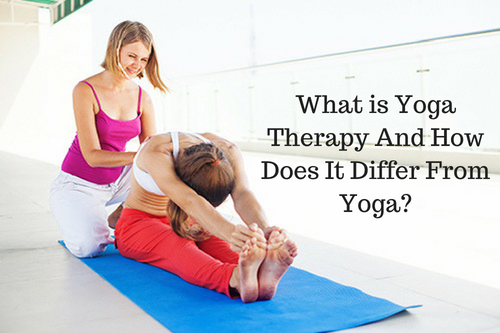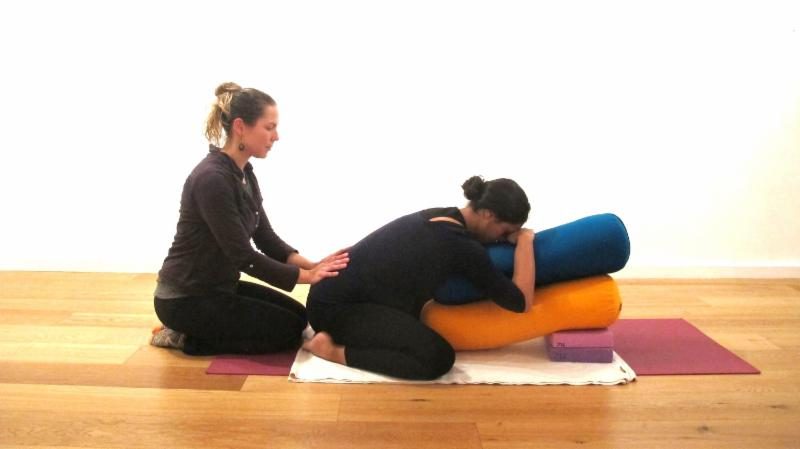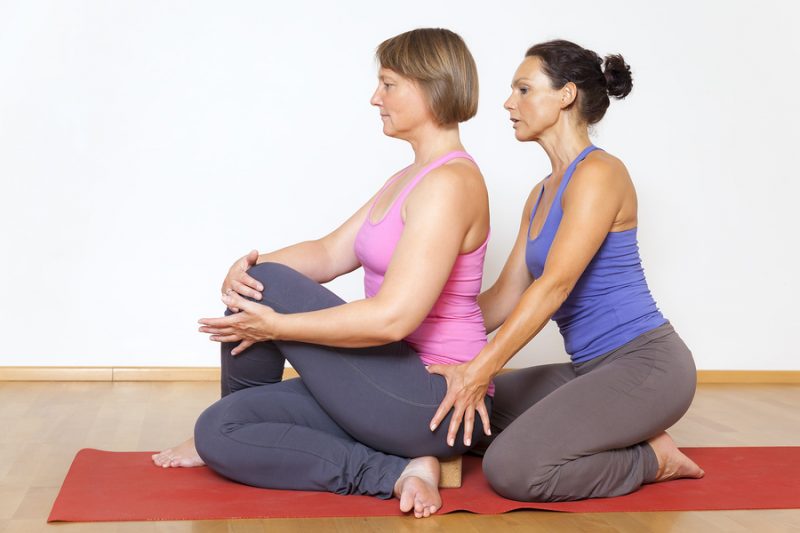
Disclosure: As an Amazon Associate I earn from qualifying purchases. This page may contain affiliate links, which means I may receive a commission if you click a link and purchase something that I have recommended. There is never an additional cost to you.
What is Yoga Therapy?
Yoga Therapy is the application of yoga practices to alleviate physical and mental health conditions with the view of promoting self-care and encouraging overall well-being.
Whilst the practice of yoga in general aims to cultivate the body and mind and hence has the potential for therapeutic effects, in yoga therapy we are using specific yoga practices and their known benefits to help alleviate or improvement mental and physical ailments
Who Invented Yoga Therapy?
‘Yoga therapy’ is a modern term, coined by Swami Kuvalyananda in the 1920s. He believed it would be possible to measure the physical and physiological changes that occurred through yoga practice. His passion brought foreigner researchers to India to study yoga’s effect, a magazine, an entire yoga institution and a new system.
Swami Kuvalyananda made it possible to start applying the specific effects of yoga to medical conditions.
When was Yoga Therapy Invented or first used?

The modern term ‘Yoga therapy’ was originally used in the 1920’s, but yoga therapy was re-introduced to North America in a publication by Dr. Dean Ornish concerning the study of the effects of lifestyle intervention on heart disease. The study demonstrated heart disease could be reversed through lifestyle changes which included therapeutic Yoga, meditation, and diet.
By the 1990s, the Program for Reversing Heart Disease was approved for health insurance coverage, making Yoga therapy a part of medical procedures.
Since the introduction of Dr. Ornish’s enlightening program for reversing heart disease, research for many other conditions has been explored and developed. Research has proven Yoga breathing exercises (pranayama) used in a therapeutic context helps manage symptoms of disease and often makes ailing patients feel better.
Some of the many conditions Yoga therapy has relieved are: Depression, insomnia, breathing difficulties, carpal tunnel syndrome, fibromyalgia, mourning, sciatica and muscle tension, autoimmune illnesses, nervousness, perfectionism, and many other ailments.
In the UK, the British Council of Yoga Therapists was formed in 2002, when many of the smaller Yoga Therapy groups were amalgamated into one group. The BCYT has continued to flourish and is the first port of call for many would be therapists and patients alike. To contact them go to http://www.bcyt.co.uk/contact-us.php
So what’s the difference between Yoga and Yoga Therapy?

If we discuss this in class setting terms, you may understand the difference better. Most yoga teachers thoughtfully prepare multiple sequences for an entire class. Each student coming to class does the same poses and breathing practices all together, like one big happy yoga family. Because each class has some variety in the level and experience of the students, yoga teachers offer as many modifications as possible while keeping within the pace of the class. Often yoga teachers manage the music and lighting for the room and help direct bodies and props like a good traffic cop. It’s a real feat of coordination to create a seamless experience for the students.
The yoga therapist, on the other hand, gears the practice to the individual and guides them within the framework of what each student wants and needs. So rather than the yoga student fitting themselves into the same poses and sequences as everyone else in the same class, a yoga therapy student does a practice that is customized for them.
What ailments can Yoga Therapy be used to treat?

1. Mental Health Conditions
- Depression
- Anxiety
- Stress
- PTSD
- Schizophrenia
- Eating Disorders
- Addiction
- Autism
- ADHD
- Post-Natal Depression
2. Physical Conditions
- Musculaskeletal problems
- Diabetes
- Back Pain
- Parkinson’s
- Asthma
- High Blood Pressure
- Cancer
- HIV
- Alzheimer’s
- COPD
- Brain Injury
- Multiple Sclerosis
- IBS
- Obesity
- Heart Disease
- Insomnia
- Autoimmune Diseases
- Arthritis
- Osteoporosis
How do I find a Yoga Therapist?
You can find a list of all UK based Yoga Therapist here http://www.bcyt.co.uk/bcyt-members.php
How do I become a Yoga Therapist?

The BCTY (The British Council for Yoga Therapy), brings together professional organisations involved in the training or support of Yoga Therapists. It promotes high standards within the profession of Yoga Therapy including the development of training and accreditation of courses in yoga therapy. It also liaises with the Complementary and Natural Healthcare Council (CNHC), the national regulatory body and supports the regulation process.
It promotes yoga therapy to the public, medical profession including the NHS, government, other national bodies and other complementary therapy organisations which encourage research into Yoga Therapy in the UK and awareness of research already undertaken.
More details can be found here at http://www.bcyt.co.uk/accreditation.php
What Courses are recognised in Yoga Therapy?
- Sadhana Mala Art of Individual Teaching run by Sadhana Mala, Association for Yoga Studies
- Yoga Therapy Teacher Training Module run by True Yoga
- CYS Practitioner course run by Centre for Yoga Studies
- Yoga Therapy Diploma run by Dru (UK)
- KHYF Yoga Teacher run by KHYF UK (KYHF UK now changed to TSYP)
- Minded Yoga Therapy run by The Minded Institute
- The Real Yoga Diploma in Yoga Therapy run by Real Yoga
- Post-Graduate Diploma in Integrated Yoga Therapy run by Clear Mind Institute
- Birthlight Perinatal Yoga Diploma run by Birthlight (for work with Perinatal Women only)
- Yoga Therapy Diploma run by Yogacampus
For people new to Yoga, training in Yoga Therapy is not an entry-level course. It is essential that each trainee has substantial experience of Yoga before beginning therapy training to be a fully qualified Yoga therapist and for registration with CNHC.
What can I expect when I visit a Yoga Therapist?

- Your first visit will be to discuss your needs, answer questions and develop an understanding of the processes involved
- During the first session your yoga therapist will work with you to come up with a preliminary plan of daily practice. They will probably recommend a minimum of six sessions to begin with. Your plan will typically involve the elements of asana (yoga postures), pranayama (breathing techniques), and meditation. You are free to continue with other forms of treatment and, indeed, yoga can be used alongside other modalities very easily.
- Yoga Therapy is all about empowering the individual. So the Yoga Therapist will often prescribe practices for you to do at home. Yoga therapy is about teaching people the skills to help themselves in their own lives.
- Yoga therapy meets each and every person where they are. No health presentation is too great nor too small. Yoga therapy sessions are client-led, client-focused, and compassion-focused. The client is the master of their journey with their yoga therapist being a knowledgeable accompanier on the journey towards health and healing.